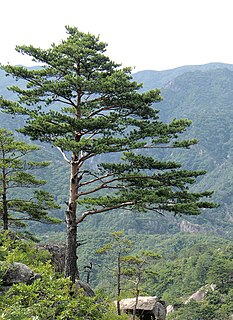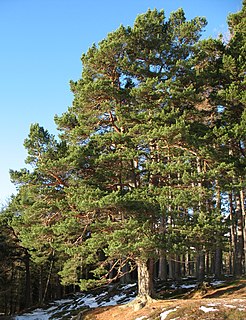
Scots pine is a species of pine that is native to Eurasia, ranging from Western Europe to Eastern Siberia, south to the Caucasus Mountains and Anatolia, and north to well inside the Arctic Circle in Scandinavia. In the north of its range, it occurs from sea level to 1,000 m (3,300 ft), while in the south of its range it is a high altitude mountain tree, growing at 1,200–2,600 m (3,900–8,500 ft) altitude. It is readily identified by its combination of fairly short, blue-green leaves and orange-red bark.

The term bristlecone pine covers three species of pine tree. All three species are long-lived and highly resilient to harsh weather and bad soils. One of the three species, Pinus longaeva, is among the longest-lived life forms on Earth. The oldest Pinus longaeva is more than 5,000 years old, making it the oldest known individual of any species.
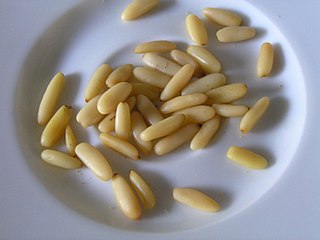
Pine nuts, also called piñón or pinoli, are the edible seeds of pines. About 20 species of pine produce seeds large enough to be worth harvesting; in other pines the seeds are also edible, but are too small to be of notable value as a human food.
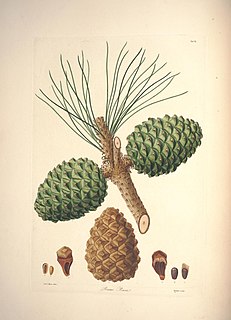
Pinus mugo, known as creeping pine, dwarf mountainpine, mugo pine, mountain pine, scrub mountain pine or Swiss mountain pine, is a species of conifer, native to high elevation habitats from southwestern to Central Europe.

Pinus nigra, the Austrian pine or black pine, is a moderately variable species of pine, occurring across southern Mediterranean Europe from Spain to the eastern Mediterranean on Anatolian peninsula of Turkey and on Corsica/Cyprus, including Crimea, and in the high mountains of the Maghreb in North Africa.

Pinus jeffreyi also known as Jeffrey pine, Jeffrey's pine, yellow pine and black pine, is a North American pine tree. It is mainly found in California, but also in the westernmost part of Nevada, southwestern Oregon, and northern Baja California. It is named in honor of its botanist documenter John Jeffrey.

Pinus strobus, commonly denominated the eastern white pine, northern white pine, white pine, Weymouth pine (British), and soft pine is a large pine native to eastern North America. It occurs from Newfoundland, Canada west through the Great Lakes region to southeastern Manitoba and Minnesota, United States, and south along the Appalachian Mountains and upper Piedmont to northernmost Georgia and perhaps very rarely in some of the higher elevations in northeastern Alabama.

Pinus contorta, with the common names lodgepole pine and shore pine, and also known as twisted pine, and contorta pine, is a common tree in western North America. It is common near the ocean shore and in dry montane forests to the subalpine, but is rare in lowland rain forests. Like all pines, it is an evergreen conifer.

Pinus echinata, the shortleaf pine, is a species of pine native to the eastern United States from southernmost New York State, south to northern Florida, west to eastern Oklahoma, and southwest to eastern Texas. The tree is variable in form, sometimes straight, sometimes crooked, with an irregular crown. This tree reaches heights of 20–30 metres (65–100 ft) with a trunk diameter of 0.5–0.9 metres.

Pinus virginiana, the Virginia pine, scrub pine, Jersey pine, is a medium-sized tree, often found on poorer soils from Long Island in southern New York south through the Appalachian Mountains to western Tennessee and Alabama. The usual size range for this pine is 9–18 m, but can grow taller under optimum conditions. The trunk can be as large as 0.5 m diameter. This tree prefers well-drained loam or clay, but will also grow on very poor, sandy soil, where it remains small and stunted. The typical life span is 65 to 90 years.

Jack pine is an eastern North American pine. Its native range in Canada is east of the Rocky Mountains from the Mackenzie River in the Northwest Territories to Cape Breton Island in Nova Scotia, and the north-central and northeast of the United States from Minnesota to Maine, with the southernmost part of the range just into northwest Indiana and northwest Pennsylvania. It is also known as grey pine and scrub pine.

Pinus ponderosa, commonly known as the ponderosa pine, bull pine, blackjack pine, or western yellow-pine, is a very large pine tree species of variable habitat native to the western United States and Canada. It is the most widely distributed pine species in North America.
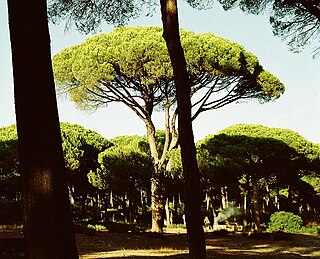
The stone pine, botanical name Pinus pinea, also known as the Italian stone pine, umbrella pine and parasol pine, is a tree from the pine family (Pinaceae). The tree is native to the Mediterranean region, occurring in Southern Europe, Israel, Lebanon and Syria. It is also naturalized in North Africa, the Canary Islands, South Africa and New South Wales. The species was introduced into North Africa millennia ago, such a long time that it is essentially indistinguishable from being native.

Pinus brutia, the Turkish pine, is a pine native to the eastern Mediterranean region. The bulk of its range is in Turkey, but it also extends to southeastern-most Bulgaria, the East Aegean Islands of Aegean Sea, Crete, the Crimea, Iran, Georgia, Azerbaijan, northern Iraq, western Syria, Israel, north-west Jordan, Lebanon, and Cyprus. It generally occurs at low altitudes, mostly from sea level to 600 metres (2,000 ft), up to 1,200 metres (3,900 ft) in the south of its range.

Pinus sibirica, or Siberian pine, in the family Pinaceae is a species of pine tree that occurs in Siberia from 58°E in the Ural Mountains east to 126°E in the Stanovoy Range in southern Sakha Republic, and from Igarka at 68°N in the lower Yenisei valley, south to 45°N in central Mongolia.
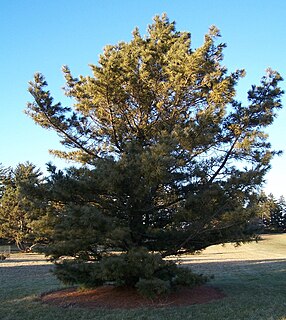
Pinus koraiensis is a species of pine known commonly as the Korean pine. It is native to eastern Asia: Korea, northeastern China, Mongolia, the temperate rainforests of the Russian Far East, and central Japan. In the north of its range, it grows at moderate altitudes, typically 600 metres (2,000 ft) to 900 metres (3,000 ft), whereas further south, it is a mountain tree, growing at 2,000 metres (6,600 ft) to 2,600 metres (8,500 ft) altitude in Japan. Other common names include Chinese pinenut.

Pinus halepensis, commonly known as the Aleppo pine, also known as Jerusalem's oren, is a pine native to the Mediterranean region. Its range extends from Morocco, Algeria and Spain north to southern France, Italy, Croatia, Montenegro, Albania, and east to Greece, all over Malta and northern Tunisia, with an outlying population in Syria, Lebanon, southern Turkey, Jordan, Israel, and Palestinian territories.
Pine honey Turkish: çam balı is a type of honeydew honey. It is a sweet and spicy honey, with some woody notes, a resinous fragrance and dark amber color. It is a common breakfast dish in Turkey, where it is drizzled over yoghurt and eaten with bread.
